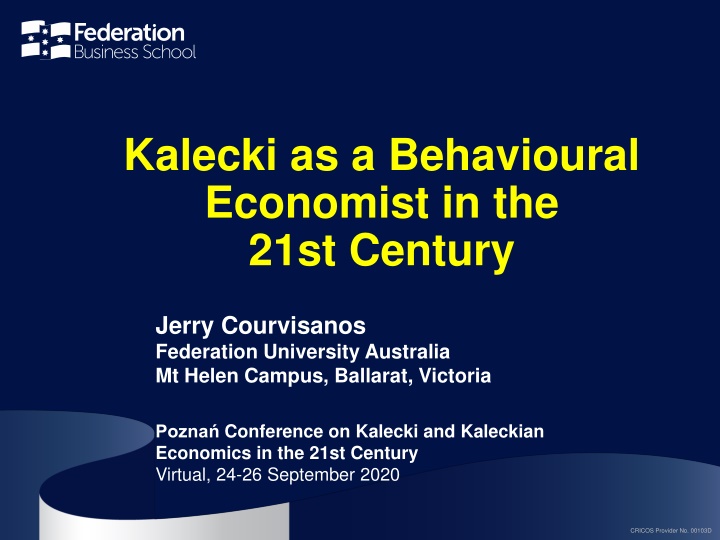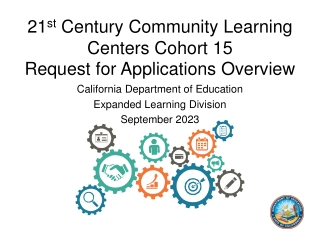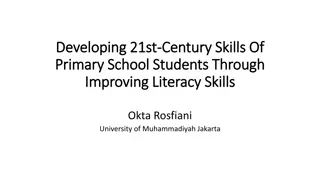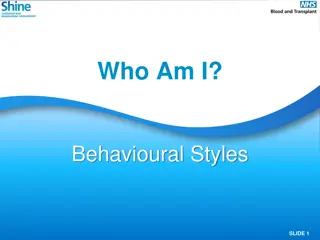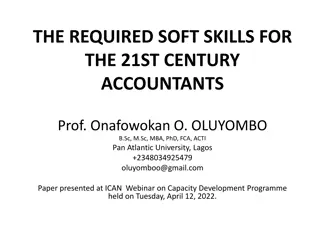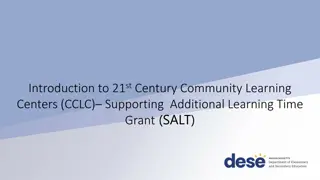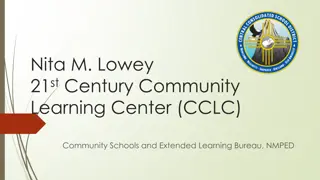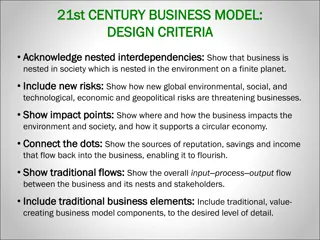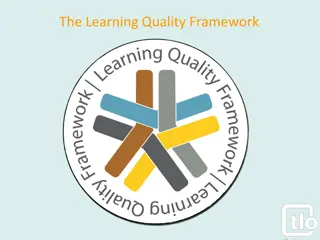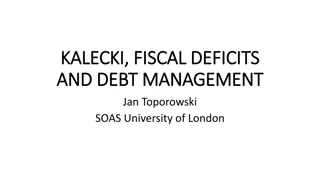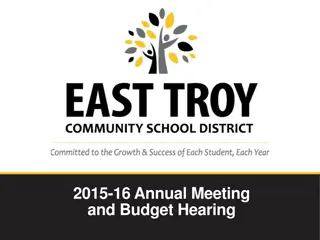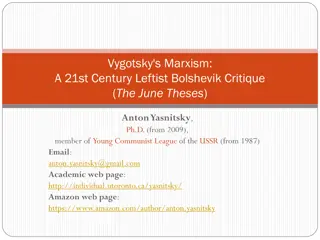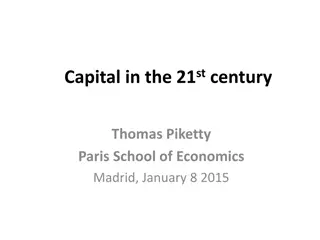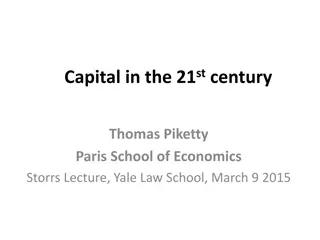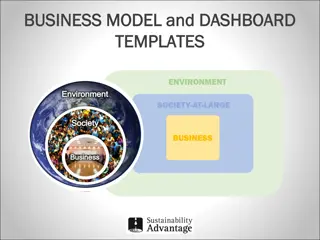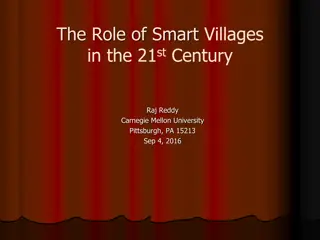Kalecki as a Behavioural Economist in the 21st Century
This paper explores the application of Kalecki's theories in behavioural economics in the context of the 21st century, focusing on the impact of technological and structural changes on economic behavior. It discusses Kalecki's analysis in relation to evolutionary economics and addresses key research areas identified in the 1999 agenda for behavioural evolutionary analysis, highlighting the shift from manufacturing to services and the role of demand and supply in policy analysis.
Download Presentation

Please find below an Image/Link to download the presentation.
The content on the website is provided AS IS for your information and personal use only. It may not be sold, licensed, or shared on other websites without obtaining consent from the author.If you encounter any issues during the download, it is possible that the publisher has removed the file from their server.
You are allowed to download the files provided on this website for personal or commercial use, subject to the condition that they are used lawfully. All files are the property of their respective owners.
The content on the website is provided AS IS for your information and personal use only. It may not be sold, licensed, or shared on other websites without obtaining consent from the author.
E N D
Presentation Transcript
Kalecki as a Behavioural Economist in the 21st Century Jerry Courvisanos Federation University Australia Mt Helen Campus, Ballarat, Victoria Pozna Conference on Kalecki and Kaleckian Economics in the 21st Century Virtual, 24-26 September 2020 CRICOS Provider No. 00103D CRICOS Provider No. 00103D
Behavioural analysis: 1990 and 2020 1990: Presentation in Warsaw to commemorate the centenary birth of Kalecki (published as Courvisanos, 2004) Grounded in Courvisanos (1996) on physical investment decision-making behaviour by large manufacturing firms (1945-1990) Structural sectoral changes in the global economy emerged in 1990 with the World Wide Web Set up in 1999 presentation, a behavioural Kalecki analysis for this New Economy , in the context of Evolutionary Economics (EE)
Behavioural analysis: 1990 and 2020 EE has for a long time addressed technical change and structural change from a systems perspective, recognising shift from manufacturing to services Seven areas of research identified in 1999 agenda for exploratory Kaleckian behavioural evolutionary analysis. Some aspects of this agenda have been undertaken by the author over the subsequent 20 years This presentation provides reflections of 1990 presentation after 20 years of working in this field
Behavioural analysis: 1990 and 2020 Seven areas of research identified in 1999 agenda: 1. Endogenous/exogenous innovation on cycles and growth 2. Traverse in cumulative path of investment and innovation; regional development and resilience 3. Linking demand (Keynesian) and supply (evolutionary) sides in modelling and policy analysis 4. Role of full employment in an IT services-based economy; role of class as per Political Business Cycle (PBC)
Behavioural analysis: 1990 and 2020 Seven areas of research identified in 1999 agenda: 5. Rules and conventions and their behavioural base from a bounded rationality perspective; need for change at micro-level from macro-level foundations 6. Income inequality in the New Economy; information- rich reproduction and role of information-poor in economic development 7. Instrumental analysis for planning in sustainable development with role for grass roots movements These all point to significant distinction from Keynesian
Behavioural analysis: 1990 and 2020 Behavioural analysis: 1990 and 2020 New Economy : First intensive phase of the Third Industrial Revolution based on the power of information technology (IT) as a General Purpose Technology (GPT) GPT enables all industry sectors to change their organisational forms and business structures (Nuvolari, 2019) First 20 years of 21stCentury show how IT through GPT facilitated a set of significant events that shape this narrative
Significant IT enabled events Significant IT enabled events Tech Wreck (March 2020) shifted funds into financial innovations (Rohit, 2013) which gave rise to the GFC (2007-09) which resulted in short-term concerted efforts of government stimulus, but quickly pivoted to austerity programmes, leading to stagnant or weak economic performance in advanced economies (Arestis, 2015) Opportunity for rise of China with export-based development, moving into mature slower growth phase from 2012 (Feng, 2019)
Significant IT enabled events Significant IT enabled events Exacerbation of national inequalities (Stilwell, 2019) with accompanying rise of the Precariat Class and populist politics (Standing, 2018) No developing in poorest economies persistent narrow range of commodity and services production, while missing IT GPT; digital divide (Crenshaw & Robison, 2006; Rodrik, 2014) IT-enhanced globalisation exposing global economies to intensification of environmental degradation (Newell, 2013) and (now) COVID-19
Behavioural economics Behavioural economics 1. Neuroscience Decision-making based on discrete choice incorporating two systems of thinking Right-brain (fast) custom/ habit/convention/emotional; Left-brain (slow) logical/ calculating/effort 2. Economics in action i) Loss aversion and endowment ii) Cognitive framing and reflexivity 3. Analysis Past as guide (real world) + guide, support and incentive for change (political economy) above based on (Earl, 1990)
New New Kaleckian Kaleckian frame for 21 frame for 21st stCentury Century 1. Epistemology (realism) Stylized facts based on IT significant enabled events Different real world to the world experienced by Kalecki, when manufacturing-working class dominated 2. Procedural rationality (uncertainty) Living in unprecedented times , even before COVID New conventions around different framing is required (previous century frames not operable: BLM, Rio Tinto) 3. Organistic perspective Production focus: globalised interdependence/complexity (adopted from Post-Classical paradigm: Lavoie, 1992)
Kaleckian Kaleckian model of behavioural action model of behavioural action Orders of change derived from social learning (Hall, 1993) Under new frame with Lowe (1976) system behaviour goal-oriented traverse pathway (Demirbag and Halevi, 2015) 1. First order change Incremental routines and adopted satisficing behaviour need to adjust to new frame for fast thinking (desired excess capacity, gearing, interest rate changes) 2. Second order change Policy strategy/actions that require addressing policy changes in budgets and annual performance goals; add more slow thinking
Kaleckian Kaleckian model of behavioural action model of behavioural action 3. Third order change Identify conditions for transition to a new economic development regime. These are slow thinking actions that address implementation of a traverse from existing model of development based on optimal growth to one of non-optimal satisficing sustainable development Need to re-examine structure of production, especially at the level of technologies and capital goods with the production of the latter cascading through all sectors, and upwards to the 1stand 2ndorder changes All community interests (stakeholders) involved
Critical realism on Critical realism on Kaleckian Kaleckian literature literature Affirmative aspects Recognise need to end austerity state policies and shift income distribution away from excess profits Intellectual base: neo-liberal agenda since mid-1970s Adverse aspects Policy response and theoretical modelling is wages-led growth; consistent with Kaleckian analysis of the C20th Two objections rooted in C21st realist perspective: 1. Obstacles to wages-led massive (see King, 2019) 2. Growth objective per se does not deliver full employment and exacerbates ecological decay
Critical realism on Critical realism on Kaleckian Kaleckian literature literature Failed agency Appropriate agency in manufacturing working class time, but political agency in C21st is different when Kalecki s reserve army is often employed in precarious work. The Precariat Class - from high educated casual teachers and taxi drivers to slave labour (McGrath, 2013) - highly exploited and made up of three forms of failed agency: 1. Lost in the past (appeal to right/left populist politics) 2. No home migrants (refugees, temporary, students) 3. Progressive educated + huge debts (inactive apathy ) (Standing, 2018)
Critical realism on Critical realism on Kaleckian Kaleckian literature literature Inappropriate institutional setting Structure of developed economies based on IT enablers: Capitalists split: long-term entrepreneurs and short-term speculators Unions greatly reduced relevance, discipline via precarious jobs Wage theft is rife in many industries Insecurity of work in Gig Economy Reliance on credit and savings by workers, not spending all income Transfer of jobs to less developed economies Structure of less developed economies based on unequal trading relations with developed economies, and limited IT enabling (Le Heron, 2015; Rubin, 2020)
Critical realism on Critical realism on Kaleckian Kaleckian literature literature Ten years ago Stockhammer and Ramskogler (2009) stated that Post-Keynesian Economics (PKE) has contributed valuable insights in monetary macroeconomics and medium- term growth theory. It appears these core features have become obsessive PKE debating points against neoclassical economics (despite monetary policy increasingly less relevant and growth less sustainable), to which the latter simply ignore the evidence (as with the Capital Debate in the 1960s) Kaleckian analysis has been subsumed into PKE, with its reductionist, closed Cambridge approach (Marcuzzo, 2019) and lack of political economy perspective (PBC)
Critical realism on Critical realism on Kaleckian Kaleckian literature literature Stockhammer and Ramskogler (2009) see Kalecki s PBC and its political contradictions of full employment policies ignored in PKE analysis Further, they state that PKE has little to say on issues by which some important groups of modern societies are concerned (p. 239), and specify (p. 227) that PKE: offers little on important real world phenomena like the globalisation of production and social issues like precarisation and the polarization of income distribution or ecological challenges like climate change. Also they recommend: PKE needs to cooperate institutionally with other heterodox approaches (p. 241)
Critical realism on Critical realism on Kaleckian Kaleckian literature literature Question to the audience: To what extent Kaleckian analysis answered this Stockhammer (2009) 10 years ago? has PKE particular) set out Ramskogler (and in call and in
Features of the C21st Features of the C21st Kaleckian Kaleckian system system Kalecki was a keen observer of the real world in which he lived in Poland (pre-WWII and Polish October ), UK (WWII) and USA (post-WWII); and visited (Bolivia, Cuba, India, Israel, Mexico) general-to-specific models and policy analysis (L pez and Assous, 2010) From this approach identify central features of Kaleckian system as they relate to the C21st global New Economy: Effective demand theory (role of full employment) Profit drives investment that drives profit (type of investment and role of profits) Consumption consistent with consumer needs
Features of the C21st Features of the C21st Kaleckian Kaleckian system system Two terms in C20th Kaleckian system that need to be qualified in the C21st context: Growth: GDP growth can not be the goal that can be acceded to in social (miscalculates) or ecological (ignores) terms in the C21st (see Coyle, 2014) The term needs to be heavily qualified in specific contexts as required (e.g. see my research on Timor- Leste; Courvisanos and Boavida, 2018) Focus on enhancing employment in decent jobs (see Sustainable Development Goal No. 8; As-Saber, 2019)
Features of the C21st Features of the C21st Kaleckian Kaleckian system system Two terms in C20th Kaleckian system that need to be qualified in the C21st context: Socialism: Given the disastrous results in bring about a viable humane socialism (including Kalecki under the Polish October ), future strategic planning needs to be based on Wright s (2019), taming and eroding capitalism Focus on goal-oriented journey (satisficing), not optimal goal. Use of Lowe (1976) long-term iterative planning and Kalecki (1962) short-term perspective planning (see Courvisanos, 2012)
Features Features of the C21st He [Kalecki] saw the process very much in terms analogous to a military strategy rejecting the market-oriented theory of bourgeois economists an positioning the necessity of economic planning. (White, 1977, p. 327) the C21st Kaleckian Kaleckian system system Strategy and planning COVID-19, Climate Change, ecological degradation, poverty and social injustices (systems-failure) need planning tools, not market-based motivations like subsidies & carbon taxes Systems Business operates in dynamic systems that are contradictory: cumulative cyclical process of investment ( masters of their fate ) and political business cycles. Both operate at the mesoeconomic level: sectoral innovation systems drive investment (Malerba and Nelson, 2012)
Features of the C21st Features of the C21st Kaleckian Kaleckian system system Focus on meso sector - real dimension of behaviour as big business gain decisive influence (Kalecki, 1943), but in specific sectors (Nelson, 1990) Kalecki calls innovation the most significant development effect for the long-term (Kalecki, 1954) Innovation context: profit levels as generating the ability (via equity & debt) to invest in capital goods and in innovation knowledge enhancement
Features of the C21st Features of the C21st Kaleckian Kaleckian system system EE - Economic development as an evolutionary process in which innovation works at the micro-level in forms of technology, knowledge, entrepreneurship Schumpeter inspired: complements Kalecki on innovation Path-dependent trajectory that evolves (changes) over time due to dynamic meso-economic forces of competition (at novelty level, less on price) at industry/sectoral levels (Nelson, 1990)
Features of the C21st Features of the C21st Kaleckian Kaleckian system system Schumpeter (1939) - clustering of innovation Rothbarth (1942) - need adaptation mechanism that enables clustering to become investment bunching: the innovation impulse Kalecki (1954) provides this mechanism through profit link to investment (in capital stock) Kalecki (1964) recognise supply-side issues in less developed economies where class and State relations dominate ( Intermediate Regimes ): still operates
Features of the C21st Features of the C21st Kaleckian Kaleckian system system Both Schumpeter and Kalecki identify explicitly the innovation and development factors that determine the new investment s ability to capture profit increments In Kalecki, this process is set in historical time Innovation is controlled in capitalism by big business and drives State-based innovation policies under the Political Aspects of Innovation PAI (Courvisanos, 2009) Need for truly democratic State to take over control of innovation and investment and drive a goal-focused sustainable development: opportunity through United Nations Sustainable Development Goals
Sustainable Development Goals Sustainable Development Goals The essence of sustainable development is to provide for the fundamental needs of humankind in an equitable way without doing violence to the natural systems of life on earth. (Kemp and Martens, 2007, p. 5) SDGs: Path to sustainable development is non-optimal and dynamic, with ventures (& new programs) that embrace: productive union of mind and nature linking economic (profit), social (people) and ecological (planet - environment) support with local/regional/national community
Sustainable Development: Challenge and Opportunities - strategy required by the State to counter PAI
Legitimacy of the SDGs Not a debate on what to do: leads to no action IMF journal Finance & Development Dec 2019 issue on The Economics of Climate states that: We cannot hope to sustain life without taking care of nature. And we need healthy economies to lift people out of poverty and achieve the UN SDGs. (p. 5) IMF to lead action SDGs is action-oriented: each nation needs to identify its SDGs proprieties and show action via Voluntary National Review (VNR)
Behavioural Mechanisms to SDGs Need Third order change first identifying SDGs, and related targets and indicators (from UN platform) Framed by an Instrumental Analysis (Lowe) to serve as new conventions, informed by EE theories Set out GPTs transformative innovations to enable Adopt perspective planning (Kalecki) towards identified SDGs flexible, local-based democratic motivation and local voluntary conformity towards regional and nationally appropriate SDGs social learning aspect to address systems change
Behavioural Mechanisms to SDGs Cumulative effective demand with strong local niche market share for environment and social goods - based stimulus support With co-evolutionary techniques: strategic niche management, transition management, time strategies (to overcome technological lock-ins) Markets via entrepreneurs will fall into line in order to make profits through investment Investment and finance planning underpinning above
Behavioural Mechanisms to SDGs COVID-19 provides opportunity behaviourally to introduce such an Instrumental/Perspective planning approach: most economies on war /military footing and populace have (in the main) accepted it is an emergency Rejects green debates: green growth , Green New Deal and degrowth . None are viable (see Frankel, 2018; Huntley, 2020) Entry via legitimate SDGs UN platform
Thank you for your attention. For more information you can contact me on j.courvisanos@federation.edu.au
References Arestis, P. (2015), Coordination of fiscal with monetary and financial stability policies can better cure unemployment, Review of Keynesian Economics, 3(2), 233 247 As-Saber, S.N. (2019), SDG 8: Promote sustained, inclusive and sustainable economic growth, full and productive employment and decent work for all, Jean Monnet Sustainable Development Goals Network Policy Brief Series, Melbourne: RMIT University. Crenshaw, E.M. and Robison, K.K. (2006), Globalization and the digital divide: The roles of structural conduciveness and global connection in Internet diffusion, Social Science Quarterly, 87(1), 190-207. Courvisanos, J. (1996), Investment Cycles in Capitalist Economies: A Kaleckian Behavioural Contribution, Cheltenham, UK and Brookfield, US: Edward Elgar Courvisanos, J. (2004), Micha Kalecki as a behavioural economists: Implications for modern evolutionary economic analysis, in Sadowski, Z. and Szeworski, A. (eds), Kalecki's Economics Today, London: Routledge, pp. 27-41 Courvisanos, J. (2009), Political aspects of innovation, Research Policy, 38(7), 1117-1124 Courvisanos, J. (2012), Cycles, Crises and Innovation: Path to Sustainable Development A Kaleckian-Schumpeterian Synthesis, Cheltenham, UK and Northampton, MA: Edward Elgar Courvisanos, J. and Boavida, M. (2018), Review of the Roadmap for Sustainable Development in Timor-Leste: An Economic Policy Report, Global Institute for Sustainable Prosperity, Policy Report No. 102, February Coyle, D. (2014), GDP: A Brief but Affectionate History, Princeton, NJ: Princeton University Press Demirbag, R. and Halevi, J. (2015), Kaleckian traverse, socialist planning and Hayekian objections, in J. Toporowski, and L. Mamica (eds), Micha Kalecki in the 21st Century, Houndmills, Basingstoke: Palgrave Macmillan, 80-98
References Earl, P. (1990), Behavioural Economics, Cheltenham, UK and Brookfield, US: Edward Elgar Feng, K. (2019), Innovation and Industrial Development in China: A Schumpeterian Perspective on China s Economic Transformation, Milton Park: Routledge Frankel, B. (2018), Fictions of Sustainability: The Politics of Growth and Post-Capitalist Futures, Melbourne: Greenmeadows Hall, P. (1993), Policy paradigms, social learning and the state, Comparative Politics, 25(3), 275-296 Huntley, R. (2020), How to Talk About Climate Change in a Way That Makes a Difference, Crows Nest: Allen & Unwin Kalecki, M. (1935), Stimulating the business upswing in Nazi Germany, in J. Osiaty sky (ed.), Collected Works of Micha Kalecki, Vol. VI, Oxford: Oxford University Press, 1996, 196-201 [original published 1935 in Polish] Kalecki, M. (1943), Political aspects of full employment, in J. Osiaty sky (ed.), Collected Works of Micha Kalecki, Vol. I, Oxford: Oxford University Press, 1990, 347-56 [original published 1943 in Political Quarterly, 14 (4), 322-31] Kalecki, M. (1954), Theory of economic dynamics, in J. Osiaty sky (ed.), Collected Works of Micha Kalecki, Vol. II, Oxford: Oxford University Press, 1991, 205-348 [original book published 1954, London: George Allen and Unwin] Kalecki, M. (1962), Outline of a Method of Constructing a Perspective Plan (Based on Polish Experience), in J. Osiaty sky (ed.), Collected Works of Micha Kalecki, Vol. III, Oxford: Oxford University Press, 1992, 221-31 [original published 1962 in Polish] Kalecki, M. (1964), Observations on Social and Economic Aspects of Intermediate Regimes , in J. Osiaty sky (ed.), Collected Works of Micha Kalecki, Vol. V, Oxford: Oxford University Press, 1993, 6-12 [original published 1965 in Polish]
References Kemp, R. and Martens, P. (2007), Sustainable development, Sustainability, 3(2), 5-14 King, J. E. (2019), Some obstacles to wage-led growth. Review of Keynesian Economics, 7(3), 308-320 Kriesler, P. and Harcourt, G.C. (2015), The failure of economic planning: The role of the Fel dman model and Kalecki s critique, in J. Toporowski, and L. Mamica(eds), Micha Kalecki in the 21st Century, Houndmills, Basingstoke: Palgrave Macmillan, 9- 28 Lavoie, M. (1992), Foundations of Post-Keynesian Economic Analysis, Aldershot: Edward Elgar Le Heron, E. (2015), Economic policies for exit from crisis, in a post-Kaleckian model, in J. Toporowski, and L. Mamica (eds), Micha Kalecki in the 21st Century, Houndmills, Basingstoke: Palgrave Macmillan, 212-238 L pez, J. and Assous, M. (2010), Micha Kalecki, London: Palgrave Macmillan Malerba, F. and Nelson, R.R. (2012), Introduction, in F. Malerba and R.R. Nelson (eds), Economic Development as a Learning Process: Variation Across Sectoral Systems. Cheltenham, UK and Northampton, MA: Edward Elgar, 1-20 Marcuzzo, M.C. (2019), Is there a Cambridge approach to economics? in A. Sinha and A.M. Thomas, Pluralistic Economics and its History, London and New York, Routledge, 122-135 McGrath, S, (2013), Fuelling global production networks with slave labour? Migrant sugar cane workers in the Brazilian ethanol GPN, Geoforum, 44(January), 32-43 Nelson, R. (1990), Capitalism as an engine of progress, Research Policy, 19(3), 193-214
References Newell, P. (2013). Globalization and the Environment: Capitalism, Ecology and Power. John Wiley & Sons Nuvolari, A. (2019), Understanding successive industrial revolutions: A development block approach, Environmental Innovation and Societal Transitions, 32(Sept), 33-44 Rodrik, D. (2014), The past, present, and future of economic growth, Challenge, 57(3), 5-39. Rohit (2013), It s Not Over: Structural Drivers of the Global Economic Crisis, New Delhi: Oxford University Press Rothbarth, E. (1942), Review of Business Cycles by J.A. Schumpeter, The Economic Journal, 52(206/207), 223-29 Rubin, J. (2020), The Expendables: How the Middle Class Got Screwed by Globalisation, London: Scribe Schumpeter, J. (1939), Business Cycles: A Theoretical, Historical and Statistical Analysis of the Capitalist Process, 2 Volumes, New York: McGraw-Hill Standing, G. (2018). The precariat: today s transformative class? Development, 61(1-4), 115- 121 Stilwell, F. (2019), The Political Economy of Inequality, Cambridge: Polity Press Stockhammer, E. and Ramskogler, P. (2009), Post-Keynesian economics how to move forward, European Journal of Economics and Economic Policies: Intervention, 6(2), 227-246 White, M. (1977), Kalecki's theories of economic growth and Development , Journal of Contemporary Asia, 7(3), 298-331 Wright, E.O. (2019), How to be an Anticapitalist in the Twenty-first Century, London: Verso Books
Critical Realist view of Causation Critical Realist view of Causation (Source: Sayer, A. Realism and Social Science, London: Sage, p. 15)
Innovation dynamics Innovation dynamics Traverse: Tracing out a structural change human agency path of affirmative innovation specified and employed in a policy- planning framework (private and/or public) Observed traverse: Sequence of short-term irreversible events within the structure of production that evolves into structural change Transformative innovation: Innovation as spur to alter significantly current general purpose technologies (GPTs) path Evasive innovation: Innovation that supports & enhances current GPTs path, even if the innovation is radical, e.g. (i) hybrid cars, (ii) carbon capture electricity
Political Aspects of Innovation Political Aspects of Innovation With contractionary political trend in force, capitalist need for public stimulation of private investment through technological innovation Shift economic public policy from direct public investment to stimulate employment; to indirect via innovation policies (replace protection) Propose to identify three fears with innovation in a boom that result in public innovation policies to sustain evasive innovation, delaying renewal In contraction, support mounts for significant new innovation initiatives threat on new entrants
Three Fears with Three Fears with Innovation Loss of economic control: for incumbents by threat on new entrants - leads to public innovation policies to support incumbents (with IPR and R&D subsidies) that limit innovation Loss of policy control: as public support of national innovation system becomes distributed broadly - leads to neo-liberalism via privatisation, public-private partnerships, public contracting Loss of industrial control: with FE-based industrial relations - need flexibility with technical change to cut labour costs
Evolutionary and Kaleckian Themes Compared Evolutionary Kaleckian Bounded rationality Cumulative causation (learning, spillovers) Disequilibrium/historical time dynamics Endogenous technological change via novelty Mesoeconomic source Long-term patterns of development Macroeconomic source Chain of short-term decisions to long-term path Representative firm behaviour Limit to growth: demand-side (C, I, G, X-M) Changes in sectoral shares of demand impact on the rate of growth (demand-side) Heterogeneity agents technical capabilities Limit to growth: supply-side (productivity) Differences in competitiveness, rate of productivity change as a result of technological progress (supply-side) Knightian uncertainty - potential surprises Innovation to productivity Keynesian uncertainty - animal spirits Investment adopts innovation Total investment is in the institutional background (innovation system) Tangible investment principal route for innovation
The eco The eco- -sustainable framework sustainable framework Eco-sustainable Framework Investment planning criteria Supporting implementation strategies Ecological rules Sustainable long-term carrying capacities Resource-saving new capital stock Iterative flexible ex-ante planning Bottom-up monitoring and evaluation Strong niche market base Experience from current eco- sustainable innovation-based users Develop and communicate appropriate sustainability rules (e.g. Pig Pen, The Break ) Perspective planning Establish, monitor, evaluate and adapt environmental policies (e.g. CMAs, VCCAP) Cumulative effective demand Co-evolution techniques to developing and managing sustainable user-needs (e.g. Landcare, Coastcare, SmartGreen) Process of investment strategy planning in public and private sectors Methods of appropriating investment strategies Planning framework
